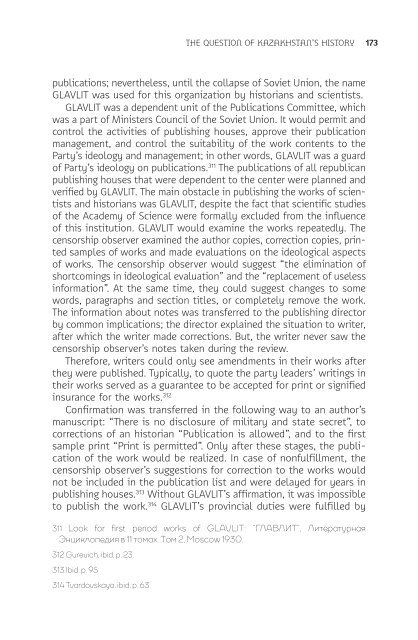THE SOVIET HISTORIOGRAPHY AND THE QUESTION OF KAZAKHSTAN’S HISTORY
SOVYET-TARIH-YAZICILIGI-ENG
SOVYET-TARIH-YAZICILIGI-ENG
Create successful ePaper yourself
Turn your PDF publications into a flip-book with our unique Google optimized e-Paper software.
<strong>THE</strong> <strong>QUESTION</strong> <strong>OF</strong> <strong>KAZAKHSTAN’S</strong> <strong>HISTORY</strong> 173<br />
publications; nevertheless, until the collapse of Soviet Union, the name<br />
GLAVLIT was used for this organization by historians and scientists.<br />
GLAVLIT was a dependent unit of the Publications Committee, which<br />
was a part of Ministers Council of the Soviet Union. It would permit and<br />
control the activities of publishing houses, approve their publication<br />
management, and control the suitability of the work contents to the<br />
Party’s ideology and management; in other words, GLAVLIT was a guard<br />
of Party’s ideology on publications. 311 The publications of all republican<br />
publishing houses that were dependent to the center were planned and<br />
verified by GLAVLIT. The main obstacle in publishing the works of scientists<br />
and historians was GLAVLIT, despite the fact that scientific studies<br />
of the Academy of Science were formally excluded from the influence<br />
of this institution. GLAVLIT would examine the works repeatedly. The<br />
censorship observer examined the author copies, correction copies, printed<br />
samples of works and made evaluations on the ideological aspects<br />
of works. The censorship observer would suggest “the elimination of<br />
shortcomings in ideological evaluation” and the “replacement of useless<br />
information”. At the same time, they could suggest changes to some<br />
words, paragraphs and section titles, or completely remove the work.<br />
The information about notes was transferred to the publishing director<br />
by common implications; the director explained the situation to writer,<br />
after which the writer made corrections. But, the writer never saw the<br />
censorship observer’s notes taken during the review.<br />
Therefore, writers could only see amendments in their works after<br />
they were published. Typically, to quote the party leaders’ writings in<br />
their works served as a guarantee to be accepted for print or signified<br />
insurance for the works. 312<br />
Confirmation was transferred in the following way to an author’s<br />
manuscript: “There is no disclosure of military and state secret”, to<br />
corrections of an historian “Publication is allowed”, and to the first<br />
sample print “Print is permitted”. Only after these stages, the publication<br />
of the work would be realized. In case of nonfulfillment, the<br />
censorship observer’s suggestions for correction to the works would<br />
not be included in the publication list and were delayed for years in<br />
publishing houses. 313 Without GLAVLIT’s affirmation, it was impossible<br />
to publish the work. 314 GLAVLIT’s provincial duties were fulfilled by<br />
311 Look for first period works of GLAVLIT: “ГЛАВЛИТ”, Литерaтурнaя<br />
Энциклопедия в 11 томaх. Том 2, Moscow 1930.<br />
312 Gurevich, ibid, p. 23.<br />
313 Ibid, p. 95<br />
314 Tvardovskaya, ibid, p. 63.



